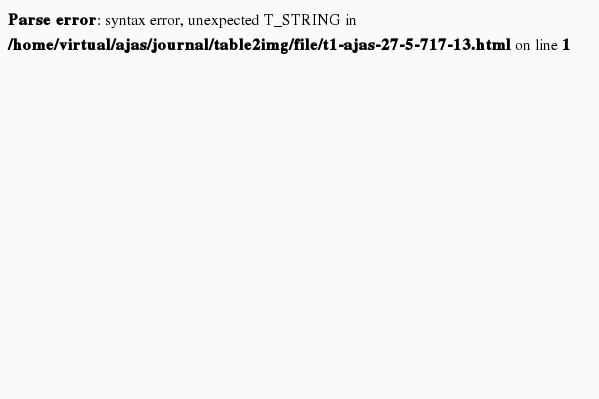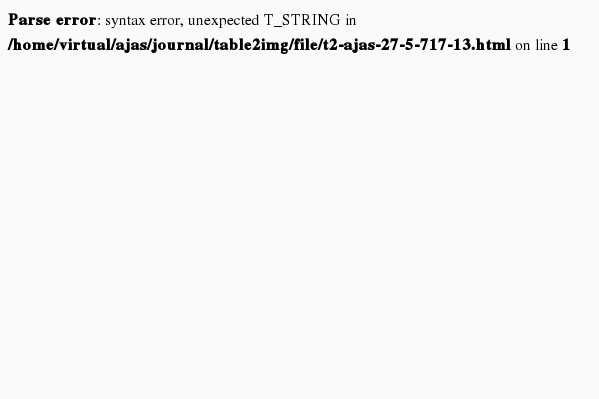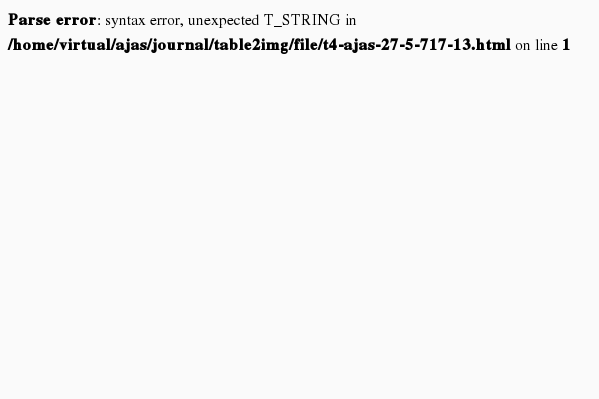Bruising in Slaughter Cattle and Its Relationship with Creatine Kinase Levels and Beef Quality as Affected by Animal Related Factors
Article information
Abstract
The objective of the study was to determine the effects of animal related factors on bruising in slaughter cattle, creatine kinase (CK) and beef quality. Three hundred and twenty one cattle from three breeds (108 Bonsmara, 130 Beefmaster and 83 Brahman) were used in this study. The animals were grouped as follows: Group 1 (16 months old), Group 2 (18 months old) and Group 3 (24 months old). At exsanguinations, blood samples for CK determination were collected using disposable vacutainer tubes. Muscularis longissimus thoracis et lumborum (LTL) was collected 24 h after slaughter to determine the colour (L*, a*, and b*) and ultimate pH (pHu) of beef. Breed, sex and age had significant effects (p<0.05) on bruising score, CK levels and beef quality. Bonsmara breed had the highest (80%) bruising score percentage, CK (705.3±80.57 U/L) and pHu (6.3±0.05) values while the Bonsmara had the highest L* (24.8±0.78) a* (17.5±0.53) and b* (12.8±0.53) values. Higher CK levels were also observed in winter compared to summer, spring and autumn respectively. Therefore, animal factors (sex, breed and animal age at slaughter) contribute to the development of bruises and have an effect on the levels of CK and meat quality. It was also concluded that there is no significant relationship between meat parameters (L,* a*, and b*) and CK levels.
INTRODUCTION
Transportation is an important activity of the farming industry. During transportation, beef cattle are grouped by their age, size and breed which are described as intrinsic factors. Grouping of these animals is done by the farm and abattoir workers. This process involves rounding up, kraaling, loading, transportation and off-loading at the abattoir (Bonney, 2006; Chulayo et al., 2012). Transportation is associated with numerous risks which include management, intrinsic and extrinsic factors; of these, intrinsic factors have been found to significantly affect the level of bruising and the quality of meat and carcass characteristics (Hoffman and Lühl, 2012). Bruising in slaughter cattle is described as a superficial discoloration due to haemorrhage of tissue from ruptured blood vessels beneath the surface of the skin (Strappini et al., 2010; Vimiso, 2010; Vimiso and Muchenje, 2013). In the contusions, the blood accumulates in the surrounding tissues, producing pain and swelling (Blood and Studdert, 1988). Bruising occurs at the farm, during transportation and at the slaughterhouse. It is speculated that sex of animals, gender and breed has an effect on animal stress. Male and young animals are at risk of more bruising than female and old animals, due to rough driving and mishandling before and after transportation (Parrot et al., 1994; Jarvis et al., 1995; Averos et al., 2008).
Cattle are prone to repeated rough handling in their lifetime which later on lead to aversive reactions such as stress and bruising immediately prior to transportation (EFSA, 2011). Stressed and bruising in animals results in an increase in the activity of creatine kinase in the blood and this is due to tissue damage and poor muscular tissue reperfusion (Knowles et al., 1999; Vojtic, 2000). In addition, capture, loading and transportation induces permeability of the muscle membrane hence increased creatine kinase (CK) levels in the blood (Warriss et al., 1995; Lopez et al., 2006; Guardia et al., 2009). CK is found in the skeletal muscles of animals and it is responsible for maintaining energy homeostasis at the sites of high adenosine tri-phosphate (ATP) (Diene and Storey, 2009; Chulayo and Muchenje, 2013). This enzyme is generally utilized as an indicator of physical stress and/or muscle damage in animal production. In goats, higher levels of CK in the plasma may also be caused by breed temperament, excitability and fighting against each other (Grzyb and Skorkowski, 2005).
The aforementioned factors, especially transportation, are documented to likely have a greater adverse effect on the welfare of calves than on mature (>17 to 19 months) age animals (Zhang et al., 2005). Grandin (2001) indicated that calf welfare is mostly affected when they are exposed to a multitude of novel and stressful events during handling and transportation. This is also witnessed by the increased incidence of mortality once they arrive at the slaughterhouse (Fike and Spire, 2006). Moreover, old animals experience similar welfare challenges which later reduce carcass quality and meat quality resulting in low economic value (Grandin, 2001). The adverse effects of transportation on welfare vary by animal type. For example, mature cattle (>500 kg) such as transported for about 400 km for slaughter had less shrinkage, deaths and bruising compared to young animals (Grandin, 2007). Therefore, poor beef quality may be influenced by the activity undertaken by the animal prior to slaughter. Beefmaster, Bonsmara, Brahman and Nguni are breeds that can withstand adverse environmental conditions (hot temperatures), long dry periods, diseases and parasites (Beatty et al., 2006; Ndlovu et al., 2008; Marufu et al., 2011). Breed affects meat quality during transportation. Aggressive breeds are more prone to bruising, injuries resulting in carcass damage and poorer meat quality (Voisinet et al., 1997).
Several studies indicate that stress lowers post mortem ultimate pH (pHu) values due to depletion of glycogen in ruminants and produces tougher meat. On the other hand pre-slaughter stress results in higher pHu and darker cuts (Devine et al., 2006; Gregory, 2010). However, there is little or no information on the relationship between creatine kinase (CK) and meat quality attributes (ultimate pH and colour). The effects of animal handling and welfare during transportation of animals from farms to commercial abattoirs have been investigated (Gispert et al., 2000; van de Water et al., 2003; Liste et al., 2008; Huertas et al., 2010). In addition, studies (Martinezo-Cerezo et al., 2005; Muchenje et al., 2009) have been conducted to determine the occurrence of bruises in cattle from the farm to the abattoir however, the level of bruising and the relation to CK values was not considered. Therefore the objective of the study was to determine the effects of animal related factors on bruising in slaughter cattle, levels of creatine kinase (CK) and the quality of beef.
MATERIALS AND METHODS
Description of the study site
The study was conducted in East London Abattoir which is located in Buffalo City Municipality. The abattoir is situated at longitude and latitude 32.′2° S and 27.′ 5° E in the Amathole District of the Eastern Cape Province of Republic of South Africa (RSA). The area has vegetation that ranges from grassland and thicket to forests and bush veld with Themeda trianda and Digitaria eriantha being the most dominant grass species. The area receives approximately 850 mm of rainfall per year of which most falls during the summer months (November, December and January). The day temperature during for the period of study ranged from 10°C to a high of 36°C, averaging about 22.3°C. The topography of the area is naturally flat with few steep slopes.
Animal management
Data was collected from 321 cattle over four seasons (winter, spring, summer and autumn) between the year 2011 and 2012. The seasons were categorised into the months as follows: winter (June to August), spring (September to October), summer (November to February) and autumn (March to May). All cattle were slaughtered at the East London commercial abattoir in the Eastern Cape Province. This abattoir operates from 0600 to 1700 h on Mondays till Fridays. On arrival at the abattoir the three breeds of cattle; Bonsmara, Brahman and Beefmaster were identified according records from the farmers. The numbers of animals per breed were 108 Bonsmara, 130 Beefmaster and 83 Brahman respectively. The animals used were both male and females and grouped according to age categories as follows: Group 1 (16 months), Group 2 (18 months) and Group 3 (24 months).
The cattle were transported by the owners from the farms to the abattoir. Transportation time (departure, arrival time and distance travelled), lairage duration, number of animals per pen, slaughtered animals per day and daily temperature were all recorded. On arrival at the abattoir, 27 offloading activities were monitored and cattle were given water ad-libitum prior to slaughter. Cattle were then slaughtered using commercial standard procedures of the abattoir. The captive bolt method was used to stun the animals, using a voltage of 300 V, a current of 5 A for 40 to 45 s at a pulse 12 beats/s.
Blood collection and plasma separation
The blood samples were collected from the animals using labelled disposable vacutainer tubes. The blood samples were placed in ice packs prior to creatine kinase (CK) analysis. A centrifuge machine (model: 5403 Centrifuge Geratebay Eppendorf GmbH, Engelsdorp Germany) was used to centrifuge blood samples at 3,550 rpm, 21°C for 10 min. Plasma was then separated and inserted into 1.5 mL Eppendorf tubes using pipettes and stored at −20°C.
Creatine kinase level determination
The serum samples were used to determine the levels of CK at the National Health Laboratory Services (NHLS), Port Elizabeth using Model DXC 600 machine (Beckman Coulter, Ireland). The contents included 2×61 ML CK Reagent, 1 preparation insert and the reactive ingredients included creatine phosphate, disodium Salt 461 mmol/L, nadide 30: 0 mmol/L, adenosine-5-diphosphate, monopotassium salt, dihydrate 36.0 mmol/L, glucose 24.0 mmol/L, glucose-6-phosphate dehydrogenase 46.1 kU/L and hexokinase 136 kU/L. All the ingredients were added for quantitative determination of CK activity of units per litre (U/L) in plasma.
Bruise measurements
Only carcasses that had bruises were considered. The assessment was done using a method based on the Australian Carcass Bruise Score System (Anderson and Horder, 1979). Bruise scores were calculated for each load by multiplying the number of bruises in each size class by a weighting factor: slight 1, medium 3, and heavy 5, and adding these values (Anderson and Horder, 1979). The bruise scores were then divided by the number of cattle per load to give a mean bruise score per animal for each load. Bruise age was estimated using the method of Gracey et al. (1999) as shown in Table 1.
Meat quality measurements
The Muscularis longisimus thoracis et Lumborum (LTL) were used for ultimate pH and colour (L*, a*, and b*) measurements. The muscle was removed by cutting a sample between the 4th and 6th ribs of the loin region while the carcass was still hanging, prior to vacuum-packing and storing in a cooler box an hour after collection and further storing in the refrigerator at −4°C.
Colour measurement
Colour of the meat (L* = lightness, a* = redness and b* = yellowness) for the Bonsmara, Beefmaster and Brahman carcasses was determined from the Muscular longissimus thoracis et. Lumborum (LTL) 24 h after slaughter using a colour-guide 45/0 BYK-Gardener GmbH machine with a 20 mm diameter measurement area and illuminant D65-day light, 100 standard observer. Three readings were taken by rotating the Colour Guide 900 machine between each measurement, in order to obtain a representative average value of the colour. This guide was calibrated each day before taking measurements using the green standard.
Determination of meat pH
Meat pH 24 from Bonsmara, Beefmaster and Brahman of carcasses was measured from the Muscularis longissimus thoracis et lumborum muscle at the level of the 10th rib 24 h after slaughter on carcasses that were stored at 0 to 3°C. The measurement was carried out using a portable pH meter (CRISON pH 25, CRISON Instruments, SA Spain). The pH meter was calibrated using pH 4, pH 7 and pH 9 standard solutions (CRISON Instrument, SA Spain) before each day’s measurement. The measurements were then performed with a sharpened metal sheath to prevent probe breakage and meat contamination.
Statistical analysis
The PROC GLM of Statistical Analysis System (SAS) Institute (2003) was used to analyse the effect of breed, age, gender and season on the activity of creatine kinase and bruising score. The model used was as follows:
where,
Yijkl = response variable (creatine kinase, bruising score and bruise age)
μ = constant mean common to all observations
αi = effect of breed
βj = effect of age group (Group 1, 2, and 3)
λk = effect of season, Gl = effect of gender and ɛijklm = random error
Significant differences between least square group means for CK and animal factors were compared using the Duncan’s procedure. Pair-wise comparison of LS means for creatine kinase concentration, sex, breed and animal age at slaughter were done using PDIFF.
The effect of breed, age group and season on CK, pHu, L,* a*, and b*, were analysed using Proc GLM of SAS (2003). The stastical model used as follows:
where,
Yijkl = Response variables (CK, pHu, L, a, b and WBSF)
μ = Overall mean
αi = breed effect (Bonsmara, Beefmaster and Brahman)
βj = age group effect (Group 1, 2, and 3)
λk = seasonal effect (summer, winter, spring and autumn)
ɛijkl = random error term
The significant difference between least square group means for CK levels and beef quality parameters were compared using Duncan multiple range procedure. Correlations were computed using PROC GLM of Statistical Analysis System (SAS) (2003) to determine the relationship between pre-slaughter condition on CK and meat quality attributes.
RESULTS AND DISCUSSION
The effect of breed on the levels of plasma creatine kinase
The Bonsmara (Table 2) breed had significantly higher (705.3±80.57 U/L) creatine kinase (CK) levels than Brahman (461.8±80.63 U/L), and Beefmaster breed (657.4±80.63 U/L) respectively. The higher CK activity in Bonsmara indicate that the breed was more susceptible to stress before slaughter and also could have been due to rough driving and mishandling before and after transportation (Broom et al., 1996; Averos et al., 2008). Warries et al. (1995) and Early et al. (2010) highlighted that animals transported for periods of between 5 to 15 h are susceptible to stress which increases the activity of creatine kinase. The reaction of this breed to longer transportation is perplexing because it has been highlighted that Bonsmara are able to withstand harsh and unfamiliar conditions (Ndlovu et al., 2008). However, if animals are transported for longer hours they have reduced plasma CK levels if they are given feed and water at the lairages.
The lower the CK levels in Brahman and Beefmaster showed that these two breeds were not susceptible to stress during transportation as compared to Bonsmara breed. This is because these are synthetic breeds which can adapt well to handling and adverse environmental conditions (Beatty et al., 2006). The activity of CK increases in the blood after tissue damage, poor muscular tissue reperfusion, decreased heat and fatigue; apparently as a result of an increase in the permeability of the muscle membranes induced by capture, loading and transportation (Lopez et al., 2006; Guardia et al., 2009). Furthermore, other animals also are susceptible to transport stress leading to highest levels of CK in the blood (Yu et al., 2009).
Effect of sex and age on plasma creatine kinase levels
Male animals had the highest CK values (p<001) compared to female animals as shown in Table 3. Males were more stressed than females and this agrees with the study by Mota-Rojas et al. (2006) which indicated that the sex of the animal has an effect on the response of the animal to stress. This is because male animals are more excitable, aggressive and stress sensitive than females. Therefore, that could be the reason of increased plasma activity of CK found in steers transported for 12 to 16 h. Similar results were reported by Neal et al. (2009) who reported that male humans had higher levels of CK.
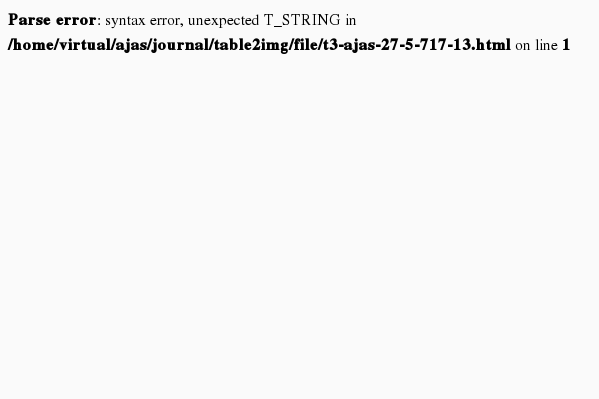
Least square means (±SE) for the effect of sex and age of animal on the activity of creatine kinase levels of cattle at slaughter
Creatine kinase levels were higher (p<0.05) in 18 months old animals than in 16 and 24 months old animals as shown in Table 3. According to Smith et al. (1998) the different levels of CK in the older animals is not well understood although it might be due to muscle fatigue as a result of strenuous exercise. Similarly, the CK levels in 16 month old animals was higher (p<0.05) than in 24 month old. Young animals are poorly adapted to cope with transportation related stress thus it results in high rates of injuries. Young animals respond to transportation stress by increasing their body temperature, heart rate and plasma cortisol concentration (Steinhardt and Thielscher, 1999). The findings of the current study are similar to those reported by Parrot et al. (1994), who observed that young animals are at risk of more bruising than older animals resulting in high levels of CK. This is also linked with CK in muscles as it is expressed in higher levels in males and younger animals (Neal et al., 2009).
Effects of season on bruising score and the levels of plasma creatine kinase
Results on the effect of season on the bruising score and CK levels are shown in Table 4. Creatine kinase (CK) was higher during the winter season (704.1±43.85 U/L) and lower in the summer season (181.3±124.09 U/L), while spring (698.3±59.19 U/L) and autumn (658.0±116.25 U/L) had intermediate CK levels. Knowles et al. (1998) observed similar results and found that CK levels were higher in winter season due to poor pre-slaughter conditions. However, other authors reported an increased CK values in lambs as a result of physical stress during summer (Lowe et al., 2002; Miranda-de la Lama et al., 2011). Wilson et al. (1990) and Liu et al. (2008) reported that vigorous physical activity and high temperatures had an effect on CK level.
Autumn had the highest (p<0.05) bruising score (1.86±1.07), while winter (1.44±0.13) and spring (1.32±0.54) had intermediate scores and the summer season had the least bruising score (1.12±0.11) as shown in Table 3 and 4. Seasonal factors mainly temperature and humidity also seem to play a role on the prevalence of bruises. Results from this study concur with Gosalvez et al. (2006) and dalla Costa et al. (2007), who found that cold weather combined with precipitation, increased the mean number of bruises per animal, although the reasons are still unclear.
Effect of breed on meat quality
Ultimate pH was significantly affected by the breed of cattle as shown in Table 5. Beef from Beefmaster and Brahman breeds had significantly higher (p<0.05) pHu values of 6.3±0.05 and 6.1±0.06, respectively compared to that of the Bonsmara breed which had an average value of 5.6±0.05. The pHu levels of Bonsmara were within the optimal range and similar to those reported by Muchenje et al. (2008). Different temperament found within an individual breed can influence meat quality due to inherent genetic parameters. The findings of this study are similar to the findings by Grandin (1997), Mormede et al. (2002), Fazio and Ferlazo (2003) who reported that breed temperament influence the degree to which animals respond to stress.
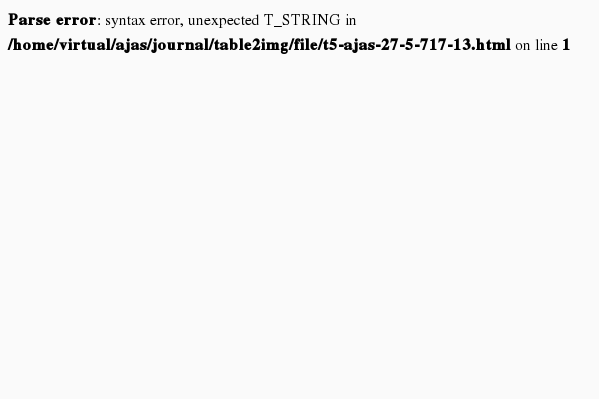
Effects of breed on ultimate pH, colour of meat and the activity of creatine kinase from beef cattle (±SEM)
The higher pH values obtained from Beefmaster and Brahman could be due to stress prior to slaughter, rough handling, inclement temperatures or anything that causes the animal to draw on its glycogen reserves before slaughter. These two breeds are known to have aggressive behaviour and are more prone to injuries resulting in carcass damage and poorer meat. The current results are similar to observations by Voisinet et al. (1997) and King et al. (2006) who found that cattle which are highly temperamental had a high incidence of borderline dark cutters than calm cattle. Brahman breed had a significant effect (p<0.05) on L* values, with darker meat than Bonsmara and Beefmaster breeds. The darker meat produced by the Brahman breed in comparison to the Bonsmara show similar trends to the findings by O’Neill et al. (2006). O’Neill et al. (2006) observed that indigenous breeds such as Bonsmara released more catecholamines than exotic breeds during the pre-slaughter period, causing the depletion of glycogen.
Bonsmara and Beefmaster had the highest a* values with Brahman having the least a* values. The a* values ranged from 17.5±0.53 in meat from Bonsmara to 13.2±0.66 in meat from Brahman. The a* values from these breeds were within the normal range. This is because pHu values were fairly normal and colour is not greatly affected by pre-slaughter conditions such as transportation. Bonsmara and Beefmaster breeds had the highest b* values (12.8±0.53) while the lowest b* values (9.6±0.61) were found from the Brahman breed. This could be due to the extent of stress during handling and transportation depending on the temperament, handling during the journey, condition of the animal, and duration of the journey resulting in pale colour of animals.
Effect of age on meat quality
The effect of age on meat quality attributes is shown in Table 6. Meat from 16, 18, and 24 months old animals had no effect on pHu. The pHu values were 6.1 in meat from 16, 18, and 24 months old. The pHu values from 16, 18, and 24 months old cattle were above the normal pH range. Meat with an ultimate pH that is above 6.0 is categorised as a dark firm dry (DFD) meat (Bartos et al., 1993; Mounier et al., 2006) with increased tenderness (Silva et al., 1999) and poor palatability (Viljoen et al., 2002; Wulf et al., 2002). This can also be attributed to the fact that an animal’s behaviour differs with its age (Terlouw, 2005). The age of the group had an effect (p<0.05) on L* values (Table 3 and 6). The L* values ranged from 25.2±0.71, 26.6±0.83, and 20.9±0.73 for 16, 18, and 24 months old cattle respectively.
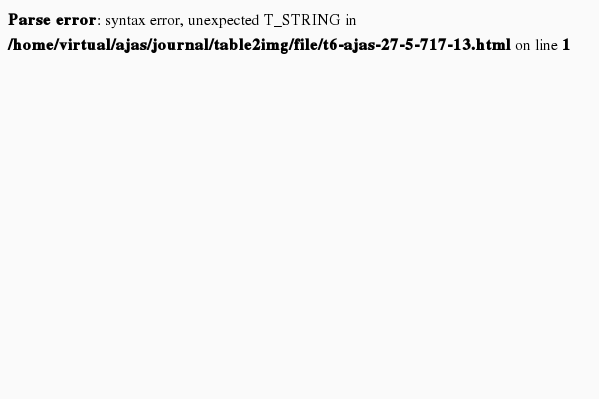
Effect of age on ultimate pH, colour of meat and the activity of creatine kinase from cattle slaughtered at the abattoir (±SEM)
Darker L* values were observed in 24 months old animals indicating meat becomes darker with increasing animal age. These results are similar to findings by Funghi et al. (1994) who found that L* values decreased with an increase in slaughtering age. Zhang et al. (2005) found that high pH meat had lower L* (lightness), a* (redness) and b* (yellowness) values than normal pH meat, indicating that high pH meat is darker and less brown than in normal pH meat. Meat from 16 month old animals had the highest a* and b* (17.9±0.53) and (12.9±0.49) and the meat from 24 months old animals had the least values of (12.9±0.54) and (9.3±0.51) respectively. Differences in meat colour has been associated with variations in intramuscular fat, moisture content and is age dependent on the muscle myoglobin content (Lawry, 1974).
Effect of breed on bruising scores of beef animals
Effect of breed on the bruising scores of slaughtered beef animals are shown in Figure 1. The Bonsmara breed had the highest percentage of non-bruised meat (88%) and the Brahman had the lowest none bruised meat (49%). Bonsmara also had highest percentage 20% of slightly bright red bruised meat (0 to 10 h old) while Brahman had lowest percentage of bright red bruised meat 4%. Susceptibility to bruising and temperament differs between individual animals. Fordyce et al. (1985) concluded that bruising score was beyond the breed differences. It appears that breed differences can be attributed to differences in behaviour and either being horned or hornless (Minka and Ayo, 2007).

Effect of breed on bruising scores of slaughtered beef animals. None = 0 h; slightly = 0 to 10 h old, red and hemorrhagic (bright-red); medium = 24 h old, dark- red colour; severe = 24 to 38 h old, watery consistency.
Bonsmara had the highest percentage 10% medium-bruised dark red (24 h old) with Brahman having the lowest bruised dark red meat 5%. This could have been due several injuries associated with road transportation. The level of bruising might increase with the length of journey travelled by the animals (Weeks et al., 2002). Brahman and Beefmaster breeds had the lowest percentage of severe deep bleeding bruising or injuries (24 to 38 h old).
Effect of age on bruising scores of beef animals
The highest number of slightly bright red bruises was observed in 16 month cattle while the 24 month old cattle had the lowest slightly bright bruised meat (Figure 2). The highest medium dark red bruises was observed in 16 month and lowest medium dark red bruise was observed in the 24 month old cattle. Young animals are more prone to bruising than old animals and this might have been due to increased poor handling (Strappini et al., 2009). Similar results were reported by von Holleben et al. (2009) indicating that the number heifers that had severe bruises were higher than either bulls or cows. However, contradicting results reported by Wythes and Shorthose (1991) highlighted that heavy animals had more bruising than young animals and mature ones and between old cows and old steers of the group. This therefore could mean that cattle bruising does not depend on the age of the animal but is mainly determined by the type of vehicle, duration of transport and handling methods used prior and after transport.
Effect of sex on bruising scores of slaughtered beef animals
Highest levels of slightly bruised meat and dark bruised meat were observed in female animals, while male animals had the lowest slightly bright bruised meat and medium dark bruised meat (Figure 3). In the literature there is evidence that female animals had higher chances for bruising than male animals (Yeh et al., 1978; Javis et al., 1995). These results are similar with Yeh et al. (1978) who found that heifers had significantly more bruises than steers and also when animals kept as separate groups, cows bruise significantly more than steers and bulls. Cows were the only class of animal where the amount of bruising increased with duration of the journey. Both male and female animals had a lower percentage of severe deep bruises.
CONCLUSION
Results from this study showed that animal factors such as sex, breed and animal age at slaughter contribute to the development of bruises, and have an effect on creatine kinase (CK) levels and meat quality. The highest percentage of slightly bruised meat was observed in Bonsmara breed, while Beefmaster and Brahman had intermediate bruising scores. Bonsmara breed had higher CK levels than Beefmaster and Brahman breeds. In addition seasonal changes also had an effect on creatine kinase and meat quality. Creatine kinase levels were higher during winter months than in spring and autumn. On the other hand, distance had a negative relationship on beef quality (L*, a*, and b*), however no correlation was observed between distance and CK levels. It was also concluded that there is no significant relationship between meat parameters (L,* a*, and b*) and CK levels.
ACKNOWLEDGEMENTS
The authors wish to acknowledge the support received from the Meat Industry Trust fund (MIT) and Project C263. This study would not be successful without the assistance from the East London abattoir and National Health Laboratory Services.
